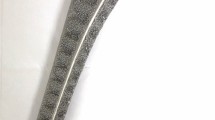Abstract
Background
In 1991, 230 cementless total hip arthroplasties (THAs) with anatomical Stolzalpe-Buchner-Graf (SBG) stems were implanted in 230 patients at our hospital. Patients were examined retrospectively and consecutively 15 years after the operations.
Methods
In total, 118 patients were available for follow-up (average 12.8 ± 3.8 years postoperatively), with 44 examined clinically/radiologically at our hospital and 74 interviewed by telephone. Five THAs needed revision (stem explantation), three for aseptic loosening. Average patient age at the time of surgery was 61 years (27–91 years). For all THAs, we implanted ceramic-to-metal heads in combination with ultra-high molecular weight polyethylene inlay (ceramic/polyethylene and metal/polyethylene articulating components).
Results
The survival rate of the SBG stem was 98.13% (CI 94.32–99.39%) with aseptic loosening as the endpoint and 96.98% (CI 92.85–98.74%) with revision and stem explantation for any other reason as the endpoint. The average Harris Hip Score was 36.0 ± 6.9 (range 22–45) preoperatively, increasing to 88.2 ± 15.3 (30–100) for clinically evaluated patients and 80.3 ± 11.3 (27–91) for telephone-interviewed patients at 15 years postoperatively. Osteolysis and radiolucent lines around the prosthetic stem were rarely observed (mainly at the proximal diaphysis).
Conclusion
These follow-up results emphasize the excellent long-term outcomes associated with the SBG stem.





Similar content being viewed by others
References
Gruen TA, McNeice GM, Amstutz HC (1979) “Modes of failure” of cemented stem-type femoral components: a radiographic analysis of loosening. Clin Orthop Relat Res 141:17–27
Zweymüller K, Samek V (1990) Radiologische Erkenntnisse der Titaniumpfanne. In: Zweymüller K (ed) 10 Jahre Zweymüller-Hüftendoprothese. Verlag Hans Huber, Bern, pp 35–46
Zweymüller K, Samek V (1990) Radiologische Grundphänomene des Titanium-Gradschaftes. In: Zweymüller K (ed) 10 Jahre Zweymüller-Hüftendoprothese. Verlag Hans Huber, Bern, pp 23–34
Brooker AF, Bowerman JW, Robinson RA, Riley LH Jr (1973) Ectopic ossification following total hip replacement. Incidence and a method of classification. J Bone Joint Surg Am 55:1629–1632
Crenshaw AA Jr (1998) Surgical techniques and approaches. In: Canale ST (ed) Campbell’s operative orthopaedics, 9th edn. Mosby, Missouri, pp 84–90
Wurnig C, Eyb R, Auersperg V (1992) Indomethacin for prevention of ectopic ossification in cementless hip arthroplasties. A prospective 1-year study of 100 cases. Acta Orthop Scand 63:628–630
Effenberger H, Graf R, May M et al (2004) Anatomically adapted, HA coated SBG stem—ten years of successful implantation. Biomed Techn 49:290–294
Engh CA, Massin P, Suthers KE (1990) Roentgenographic assessment of the biologic fixation of porous-surfaced femoral components. Clin Orthop 257:107–128
Panisello JJ, Herrero L, Herrera A et al (2006) Bone remodelling after total hip arthroplasty using an uncemented anatomic femoral stem: a three-year prospective study using bone densitometry. J Orthop Surg (Hong Kong) 14:32–37
van der Wal BC, de Kramer BJ, Grimm B et al (2007) Femoral fit in ABG-II hip stems, influence on clinical outcome and bone remodeling: a radiographic study. Arch Orthop Trauma Surg 128:1065–1072
van der Wal BC, Rahmy A, Grimm B, Heyligers I, Tonino A (2008) Preoperative bone quality as a factor in dual-energy X-ray absorptiometry analysis comparing bone remodelling between two implant types. Int Orthop 32:39–45
Panisello JJ, Canales V, Herrero L et al (2008) Changes in periprosthetic bone remodelling after redesigning an anatomic cementless stem. Int Orthop Jan 11 [Epub ahead of print]
Incavo SJ, Schneider R, Elting J (1998) The effect of surface coating of femoral prostheses implanted without cement: a 2- to 4-year follow-up study. Am J Orthop 27:355–361
Lintner F, Böhm G, Huber M, Scholz R (1994) Histology of tissue adjacent to an HAC-coated femoral prosthesis. A case report. J Bone Joint Surg Br 76:824–830
Soballe KS, Overgaard S (1996) The current status of hydroxyapatite coating of prostheses. J Bone Joint Surg Br 78:689–691
Landor I, Vavrik P, Sosna A, Jahoda D, Hahn J, Daniel M (2007) Hydroxyapatite porous coating and the osteointegration of the total hip replacement. Arch Orthop Trauma Surg 127:81–89
Grochola LF, Habermann B, Mastrodomenico N, Kurth A (2008) Comparison of periprosthetic bone remodeling after implantation of anatomic and straight stem prostheses in total hip arthroplasty. Arch Orthop Trauma Surg 128:383–392
Acknowledgment
The authors did not receive any funding related to this study.
Conflict of interest statement
No conflicts of interest are declared.
Author information
Authors and Affiliations
Corresponding author
Rights and permissions
About this article
Cite this article
Azizbaig Mohajer, M., Hofmann, F. & Graf, R. Retrospective and consecutive analysis of the long-term outcomes of the SBG stem: a 15-year follow-up study. Arch Orthop Trauma Surg 130, 185–190 (2010). https://doi.org/10.1007/s00402-009-0929-2
Received:
Published:
Issue Date:
DOI: https://doi.org/10.1007/s00402-009-0929-2




